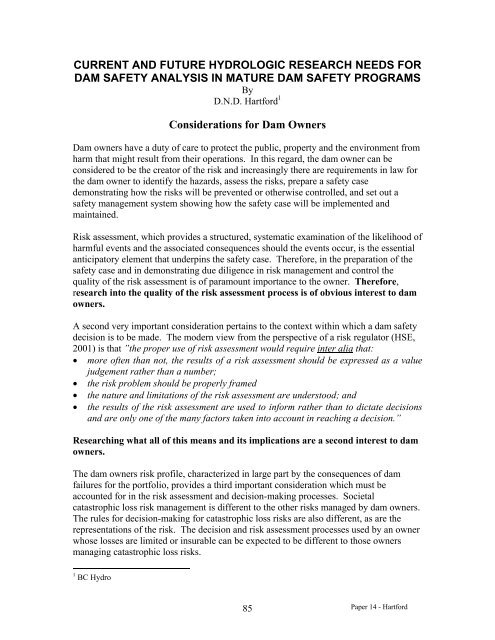Hydrologic Issues for Dams - Association of State Dam Safety Officials
Hydrologic Issues for Dams - Association of State Dam Safety Officials
Hydrologic Issues for Dams - Association of State Dam Safety Officials
Create successful ePaper yourself
Turn your PDF publications into a flip-book with our unique Google optimized e-Paper software.
CURRENT AND FUTURE HYDROLOGIC RESEARCH NEEDS FORDAM SAFETY ANALYSIS IN MATURE DAM SAFETY PROGRAMSByD.N.D. Hart<strong>for</strong>d 1Considerations <strong>for</strong> <strong>Dam</strong> Owners<strong>Dam</strong> owners have a duty <strong>of</strong> care to protect the public, property and the environment fromharm that might result from their operations. In this regard, the dam owner can beconsidered to be the creator <strong>of</strong> the risk and increasingly there are requirements in law <strong>for</strong>the dam owner to identify the hazards, assess the risks, prepare a safety casedemonstrating how the risks will be prevented or otherwise controlled, and set out asafety management system showing how the safety case will be implemented andmaintained.Risk assessment, which provides a structured, systematic examination <strong>of</strong> the likelihood <strong>of</strong>harmful events and the associated consequences should the events occur, is the essentialanticipatory element that underpins the safety case. There<strong>for</strong>e, in the preparation <strong>of</strong> thesafety case and in demonstrating due diligence in risk management and control thequality <strong>of</strong> the risk assessment is <strong>of</strong> paramount importance to the owner. There<strong>for</strong>e,research into the quality <strong>of</strong> the risk assessment process is <strong>of</strong> obvious interest to damowners.A second very important consideration pertains to the context within which a dam safetydecision is to be made. The modern view from the perspective <strong>of</strong> a risk regulator (HSE,2001) is that ”the proper use <strong>of</strong> risk assessment would require inter alia that:• more <strong>of</strong>ten than not, the results <strong>of</strong> a risk assessment should be expressed as a valuejudgement rather than a number;• the risk problem should be properly framed• the nature and limitations <strong>of</strong> the risk assessment are understood; and• the results <strong>of</strong> the risk assessment are used to in<strong>for</strong>m rather than to dictate decisionsand are only one <strong>of</strong> the many factors taken into account in reaching a decision.”Researching what all <strong>of</strong> this means and its implications are a second interest to damowners.The dam owners risk pr<strong>of</strong>ile, characterized in large part by the consequences <strong>of</strong> damfailures <strong>for</strong> the portfolio, provides a third important consideration which must beaccounted <strong>for</strong> in the risk assessment and decision-making processes. Societalcatastrophic loss risk management is different to the other risks managed by dam owners.The rules <strong>for</strong> decision-making <strong>for</strong> catastrophic loss risks are also different, as are therepresentations <strong>of</strong> the risk. The decision and risk assessment processes used by an ownerwhose losses are limited or insurable can be expected to be different to those ownersmanaging catastrophic loss risks.1 BC Hydro85Paper 14 - Hart<strong>for</strong>d

















